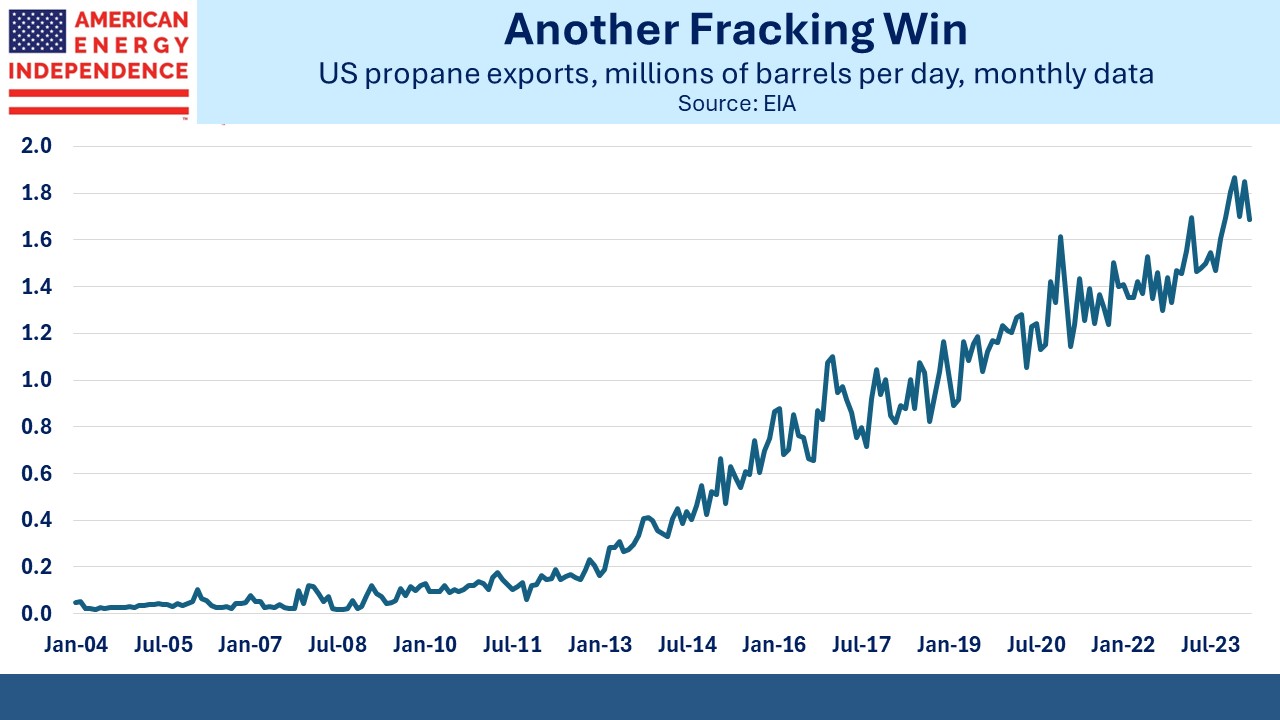The Pipeline Outlook Keeps Improving
The trend of positive assessments is continuing for the pipeline industry. Sell-side analysts are pressing the case for their favorite names. JPMorgan sees further upside for Targa Resources (TRGP) even though it’s returned 40% YTD. They have a $140 price target for the end of next year, up from ~$120 today. They cite a “fully integrated well-to-dock Permian NGL value chain” and attractive Enterprise Value /EBITDA multiple of 9.0X (2025E) versus a peer group median of 9.7X.
NGLs are natural gas liquids, mostly ethane and propane. The latter is used in agriculture (for crop drying) cooking and heating where natural gas isn’t available, and also as a petrochemical feedstock. NGLs get less attention than oil and gas, but their production has also grown through fracking. US propane exports are now well above 1.5 Million Barrels per Day. They’ve more than tripled in the past decade. TRGP is one of the beneficiaries.
Years ago when MLPs were overinvesting and investors wanted to see reduced capex, then-CEO Joe Bob Perkins would flippantly talk about “capital blessings” on earnings calls where he defended unwelcome big outlays.
Today TRGP has a greater focus on capital discipline, but it’s also fair to note that many of those prior investments have worked out fine.
Wells Fargo recently upgraded several natural gas-oriented names based on attractive valuations and power demand from AI data centers. Some investors are skeptical that enough new power plants will be built to drive the 7 Billion Cubic Feet per Day of increased natural gas demand they expect. New rules from the Environmental Protection Agency require all coal-fired and any new gas-fired power plants operating past 2039 to control 90% of their CO2 emissions, meaning capture and sequestration.
Regulations can always be changed, but the counter is that enough existing power generating plants have available capacity to drive gas demand higher anyway.
Morgan Stanley expects the median pipeline stock to return 21% over the next year, including a 6.1% median dividend yield. Buybacks are supportive of this, with $1.5BN of stock retired during 1Q24. Cheniere was $1.2BN of this and TRGP $124MM.
Some of the best energy analysts in the market remain constructive on the sector.
I’ve been searching for a good energy podcast. Progressive “renewables will solve everything and the world’s on fire” podcasts are abundant and useless. I did stumble on the educational Energy Policy Now and found Power Struggle: The Electric Grid’s Natural Gas Challenge informative. AI will drive the increased demand for natural gas. This drills down into some of the consequences.
When Storm Uri hit Texas in 2021 it didn’t only highlight the need for winterized natural gas production facilities. Many power plants had natural gas contracts that didn’t guarantee supply, because there’s a big price difference. The Texas grid, run by ERCOT, has tended to place less importance on reliability than the rest of the country in exchange for low prices. Uri led to a reassessment.
At the Federal level, NERC, which oversees electricity, prioritizes reliability while FERC, which regulates interstate natural gas, values safety most highly. Electricity “days” that govern contracts start and end at midnight, whereas gas “days” begin at 10am ET. So a gas-fired power plant faces a mismatch between its pricing for inputs versus outputs.
These problems can be solved more easily than coping with the 20-35% utilization that burdens intermittent solar and wind.
If you enjoy learning about the intricacies of the energy business, you’ll enjoy the podcast. Or you can rely on me to chronicle the highlights.
Once or twice a year I play golf with my old boss from JPMorgan, Don Layton. In 1986 he decided to hire a 23 year old derivatives broker as a trader. It was to my great benefit and hopefully not something he had later reason to regret. Don (often referred to by his initials, DHL) went on to become vice-chair of JPMorgan, running the investment bank. I soon took over interest rate derivates trading in NY.
Later in his career Don was CEO of E*Trade and then Freddie Mac, from 2012-2019.
Don was a terrific leader, with the rare ability to combine strategic vision with command of detail. I’ve remained in touch with many who used to work for Don in the 1980s and 90s. We all retain fond memories and great respect for him. On Monday we reminisced with two other former colleagues, Don Taggart and Don Allison.
DHL remains strongly competitive and draws unseemly pleasure from beating me at golf on one of his home courses. The nostalgia easily compensates.
We have three have funds that seek to profit from this environment:

